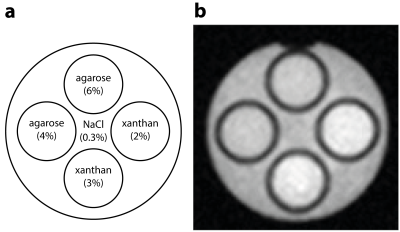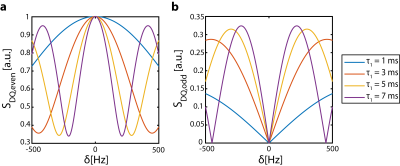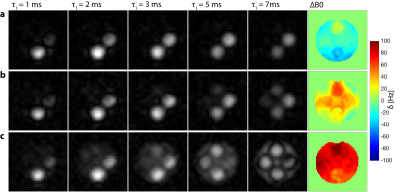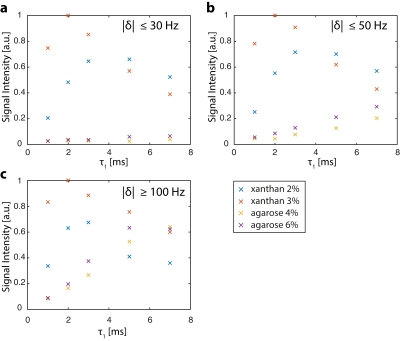3870
Double quantum filtered 23Na MRI with magic angle excitation in presence of B0-inhomogeneities1Institute of Radiology, University Hospital Erlangen, Friedrich-Alexander-Universität Erlangen-Nürnberg (FAU), Erlangen, Germany, 2Center for Medical Physics and Engineering, Friedrich-Alexander-Universität Erlangen-Nürnberg (FAU), Erlangen, Germany
Synopsis
In 23Na MRI it is possible to selectively detect signal from sodium ions bound to anisotropic structures by applying a double quantum filter with magic angle excitation (DQ-MA). In this work, the influence of B0-inhomogeneities on the DQ-MA filtering capacity was examined both theoretically and experimentally. We found that under practical conditions (|ΔB0| ≈ 50 Hz at 3T) a significant amount of unwanted odd rank double quantum coherence signal may pass the filter even in case of perfect magic angle excitation. Therefore, B0-inhomogeneities may cause an over-estimation of the degree of anisotropy.
Introduction
Double quantum filtered 23Na MRI represents a way to gain information about the sodium ions’ molecular environment. In particular, double quantum filtered sodium imaging with magic angle excitation (DQ-MA) is used to selectively detect double quantum coherences (DQC) of even rank that are connected to sodium ions bound to anisotropic structures.1,2 As the suppression of unwanted odd rank DQC relies on exact flip angles, effects of flip angle deviations on DQ-MA signal are well known.3 However, also B0-inhomogeneities may result in a reduced DQ-MA filtering capacity with respect to odd rank DQC. In this work, artifacts caused by B0-inhomogeneities in DQ-MA images are examined in detail. A full theoretical description of the DQ-MA signal dependencies on offresonances is given and experimentally verified using phantom measurements.
Methods
The derivation of the theoretical signal equation followed analogous considerations that have been performed for triple quantum filtration.4 For experimental verification, a phantom consisting of one NaCl compartment, two agarose compartments (4 and 6%) and two xanthan compartments (2 and 3%) with a sodium concentration of 50 mM in all compartments was built (see Fig. 1). Xanthan gel has been shown to possess a residual quadrupolar coupling and therefore serves as an indicator for DQ-MA filtering function.5
Measurements were conducted on a 3-Tesla whole-body MR system (Magnetom Skyra, Siemens, Erlangen, Germany). A single-resonant 23Na birdcage coil (Stark Contrast, Erlangen, Germany) was used for the measurements. All 23Na images were acquired with a three-dimensional density adapted radial readout scheme.6,7 DQ-MA measurements were conducted for low (|δ|≤ 30 Hz), medium (|δ|≤ 50 Hz) and high B0-inhomogeneities (|δ|≥ 100 Hz). Sequence parameters were TR=150 ms, TE=τ=1/2/3/5/7 ms, readout duration TRO=10 ms, nominal spatial resolution (Δx)3=12x12x24 mm3, total acquisition duration TA=8:43 min. The magic angle of 54.7° was chosen for both the second and third RF pulse. The common four-step phase cycle was applied (Φ1=Φ2=kπ/2, Φ3=0, ΦRx=kπ, k=0,1,2,3). For comparison, a conventional 3D 23Na data set was acquired with the following parameters: TR=100 ms, TE=0.3 ms, TRO=10 ms, (Δx)3=3x3x15 mm3, TA=6:53 min. Offresonance values were calculated using two 23Na images acquired at different echo times (TE1=0.3 ms, TE2=14 ms) according to
$$\delta = \frac{\Phi_2-\Phi_1}{TE_2-TE_1}$$
with $$$\Phi_1$$$ and $$$\Phi_2$$$ describing the phases of each voxel of the two images corresponding to echo time TE1 and TE2, respectively.
Results
The total double quantum filtered signal depending on preparation time τ1 and evolution time τ2, effective flip angles θ1,θ2,θ3, offresonance parameter δ and acquisition time t was derived as
$$S^{DQ}(\theta_1,\theta_2,\theta_3,\delta,\tau_1,\tau_2,t) = S^{DQ,even}+S^{DQ,odd}=e^{-i\delta t} \left[-\sin\omega_q\tau_1e^{-\frac{\tau_1}{T_{2f}}}\sin\omega_q te^{-\frac{t}{T_{2f}}}F_{22} + \left(\cos\omega_q\tau_1e^{-\frac{\tau_1}{T_{2f}}}-e^{-\frac{\tau_1}{T_{2s}}}\right)\left(\cos\omega_q te^{-\frac{t}{T_{2f}}}-e^{-\frac{t}{T_{2s}}}\right)F_{32}\right]$$
with factors F22 and F32 describing the even and odd rank DQC signal dependencies on effective flip angles and offresonances:
$$F_{22}(\theta_1,\theta_2,\theta_3,\delta,\tau_1,\tau_2)=\frac{3}{5}\sin\theta_1\sin\theta_2\sin\theta_3\left(\cos\delta\tau_1\cos 2\delta\tau_2-cos\theta_1\sin\delta\tau_1\sin 2\delta\tau_2+i\cos\theta_3\left(\cos\delta\tau_1\sin 2\delta\tau_2+\cos\theta_2\sin\delta\tau_1\cos 2\delta\tau_2\right)\right)$$
$$F_{32}(\theta_1,\theta_2,\theta_3,\delta,\tau_1,\tau_2)=\frac{3}{20} \sin\theta_1\sin\theta_2\sin\theta_3\Big((1-3\cos^2\theta_2)(1-3\cos^2\theta_3)\cos\delta\tau_1\cos 2\delta\tau_2 + 2\cos\theta_2(1-3\cos^2\theta_3)\sin\delta\tau_1\sin 2\delta\tau_2$$
$$-2i\cos\theta_3((1-3\cos^2\theta_2)\cos\delta\tau_1\sin 2\delta\tau_2 -\cos\theta_2\sin\delta\tau_1\cos 2\delta\tau_2)\Big)$$
In Fig. 2 the theoretical contributions of even and odd rank DQC to the DQ-MA signal depending on the offresonance factor δ in case of perfect magic angle excitation are visualized. The acquired DQ-MA phantom images for increasing preparation times and offresonances together with B0 maps are shown in Fig 2. Corresponding mean signal intensities of the different compartments depending on preparation time are shown in Fig. 3. For small offresonances (|δ|< 30 Hz), no significant reduction in filtering capacity is found. For medium offresonances (|δ|< 50 Hz), signal of the agarose compartments is detected at longer preparation times (τ1≥ 5 ms). In case of high offresonances (|δ|≥ 100 Hz), the filter loses its filtering characteristics, also with respect to NaCl solution, already at short preparation times (τ1≥ 3 ms).
Discussion
Fig. 2b shows that the DQ-MA signal is likely to contain contributions of odd rank DQC under practical conditions (τ1≈ 3ms, |δ|≈ 50 Hz at 3T). This effect was also found experimentally, as agarose signal in DQ-MA images is an indicator of odd rank double quantum coherences passing the filter (Fig. 3b and 4b). Filter malfunction as shown in Fig. 3c can be explained as longitudinal magnetization that builds up during preparation time and does not get filtered in case of strong offresonances. This could be mitigated using an extended phase cycle.Conclusion
In this work, the influence of magnetic field inhomogeneities on DQ-MA measurements was examined. Even in case of perfect magic angle excitation a significant amount of odd-rank DQC signal may pass the filter. As B0 artifacts increase with preparation time, it is advisable to use preparation times as short as possible. Moreover, we suggest the acquisition of B0 maps to assess contributions of odd rank DQC and obtain a more reliable estimation of anisotropy using DQ-MA measurements.
Acknowledgements
No acknowledgement found.References
1. Eliav U, Shinar H, and Navon G. The Formation of a Second-Rank Tensor in 23Na Double-Quantum-Filtered NMR as an Indicator for Order in a Biological Tissue. Journal of Magnetic Resonance, 1992; 98: 223-229.
2. Tsang A, Stobbe RW, and Beaulieu C. In vivo double quantum filtered sodium magnetic resonance imaging of human brain. Magnetic Resonance in Medicine, 2015; 73: 497-504.
3. Reddy R, et al. Multiple-Quantum Filters of Spin-3/2 with Pulses of Arbitrary Flip Angle. Journal of Magnetic Resonance, Series B, 1994; 104: 148-152.
4. Tanase C and Boada FE. Triple-quantum-filtered imaging of sodium in presence of B0 inhomogeneities. Journal of Magnetic Resonance, 2005; 174: 270-278.
5. Bezemer L and Leyte JC. Behavior of Native Xanthan in the Biphasic Region: a 23Na+ Counterion NMR Study. The Journal of Physical Chemistry, 1995; 99: 3743-3747.
6.Nagel AM, et al. Sodium MRI using a density-adapted 3D radial acquisition technique. Magnetic Resonance in Medicine, 2009; 62: 1565-1573.
7. Nagel AM, et al. 3D Density-Adapted Projection Reconstruction 23Na-MRI with Anisotropic Resolution and Field-of-View. in The ISMRM 20th Annual Meeting & Exhibition 2012. Melbourne, Victoria, Australia.
Figures



